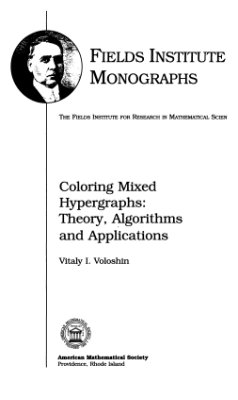American Mathematical Society, 2002, -195 pp.
The theory of graph coloring has existed for more than 150 years. From a modest beginning of determining whether every geographic map can be colored with four colors, the theory has become central in discrete mathematics with many contemporary generalizations and applications. Historically, graph coloring involved finding the minimum number of colors to be assigned to the vertices so that adjacent vertices must have different colors. In this book we introduce the theory of coloring mixed hypergraphs where problems on both the minimum and maximum number of colors occur. Mixed hypergraphs contain two families of (hyper)edges: classic edges and their opposites which may be viewed as "anti-edges". In every coloring, classic edges have at least two vertices of distinct colors, while the "anti-edges" have at least two vertices of the same color. The interaction between edges and "anti-edges" constitutes the main feature of the coloring of mixed hypergraphs. This interaction brings many new properties to the theory of colorings, for example: colorability, unique colorability, lower and upper chromatic numbers, perfection with respect to the upper chromatic number, and broken chromatic spectra. Perhaps the main conclusion is that in trying to establish a formal symmetry between the two types of constraints expressed by the edges and "anti-edges" we find a deep asymmetry between the problems on the minimum and the maximum number of colors. This asymmetry pervades the theory, methods, algorithms and applications of mixed hypergraph coloring.
This book will appeal to a broad audience. It draws together the theory, algorithms and applications of mixed hypergraph coloring and thus is appealing to researchers in discrete mathematics, operations research, and computer science. Furthermore the book presents some new and challenging problems that should attract graduate students looking for thesis topics.
The Lower Chromatic Number of a Hypergraph.
Mixed Hypergraphs and the Upper Chromatic Number.
Uncolorable Mixed Hypergraphs.
Uniquely Colorable Mixed Hypergraphs.
C-perfect Mixed Hypergraphs.
Gaps in the Chromatic Spectrum
Interval Mixed Hypergraphs.
Pseudo-chordal Mixed Hypergraphs.
Circular Mixed Hypergraphs.
Planar Mixed Hypergraphs.
Coloring Block Designs as Mixed Hypergraphs.
Modelling with Mixed Hypergraphs.
The theory of graph coloring has existed for more than 150 years. From a modest beginning of determining whether every geographic map can be colored with four colors, the theory has become central in discrete mathematics with many contemporary generalizations and applications. Historically, graph coloring involved finding the minimum number of colors to be assigned to the vertices so that adjacent vertices must have different colors. In this book we introduce the theory of coloring mixed hypergraphs where problems on both the minimum and maximum number of colors occur. Mixed hypergraphs contain two families of (hyper)edges: classic edges and their opposites which may be viewed as "anti-edges". In every coloring, classic edges have at least two vertices of distinct colors, while the "anti-edges" have at least two vertices of the same color. The interaction between edges and "anti-edges" constitutes the main feature of the coloring of mixed hypergraphs. This interaction brings many new properties to the theory of colorings, for example: colorability, unique colorability, lower and upper chromatic numbers, perfection with respect to the upper chromatic number, and broken chromatic spectra. Perhaps the main conclusion is that in trying to establish a formal symmetry between the two types of constraints expressed by the edges and "anti-edges" we find a deep asymmetry between the problems on the minimum and the maximum number of colors. This asymmetry pervades the theory, methods, algorithms and applications of mixed hypergraph coloring.
This book will appeal to a broad audience. It draws together the theory, algorithms and applications of mixed hypergraph coloring and thus is appealing to researchers in discrete mathematics, operations research, and computer science. Furthermore the book presents some new and challenging problems that should attract graduate students looking for thesis topics.
The Lower Chromatic Number of a Hypergraph.
Mixed Hypergraphs and the Upper Chromatic Number.
Uncolorable Mixed Hypergraphs.
Uniquely Colorable Mixed Hypergraphs.
C-perfect Mixed Hypergraphs.
Gaps in the Chromatic Spectrum
Interval Mixed Hypergraphs.
Pseudo-chordal Mixed Hypergraphs.
Circular Mixed Hypergraphs.
Planar Mixed Hypergraphs.
Coloring Block Designs as Mixed Hypergraphs.
Modelling with Mixed Hypergraphs.

